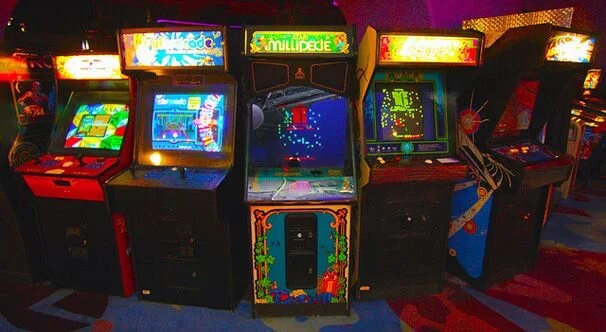In the fast-paced world of business, understanding the strategic approaches and innovative techniques that have shaped successful ventures is crucial. One industry that has captivated enthusiasts and entrepreneurs alike is the realm of classic arcade games.
From the rise and fall of arcade gaming to the challenges faced by game developers, this article explores the enduring appeal of classic arcade games and the lessons they hold for modern-day businesses.
Prepare to embark on a captivating journey through the annals of arcade gaming as we uncover the secrets behind their enduring success. Discover the fascinating narrative and valuable insights into the evolution of business strategies that these beloved games offer.
Stay ahead of the competition by delving into the untold history of classic arcade games and applying the lessons learned to your own ventures.
Key Takeaways
- Classic arcade games gained popularity in the 1970s and became social gathering places.
- The evolution of arcade gaming technology brought about improvements in graphics, sound quality, and online connectivity.
- Classic arcade games have had a significant impact on pop culture, evoking nostalgia and creating cultural icons.
- Arcade game developers face challenges such as staying ahead of technological advancements and balancing gameplay with monetization.
The Rise of Arcade Games
The Rise of Arcade Games can be traced back to the 1970s when these interactive entertainment machines first gained popularity among gaming enthusiasts. These early arcade games captivated players with their simple yet addictive gameplay, offering a unique experience that couldn’t be replicated at home. As technology advanced, arcade games became more sophisticated, incorporating colorful graphics, sound effects, and multiplayer capabilities.
One of the key factors contributing to the rise of arcade games was the social aspect they offered. Arcades became gathering places where people could come together to compete, collaborate, and connect with fellow gamers. This sense of community and belonging was a major draw for players, creating a shared experience that couldn’t be replicated in solitary home gaming.
The rise of arcade games also coincided with the emergence of popular franchises like Pac-Man, Space Invaders, and Donkey Kong. These iconic games captured the imagination of players worldwide, becoming cultural phenomena in their own right. Players were drawn to the challenge of mastering these games and achieving high scores, fueling a competitive spirit that drove the popularity of arcade gaming.
Furthermore, the accessibility of arcade games played a significant role in their rise. Arcade machines were easily found in shopping malls, movie theaters, and amusement parks, making them readily available to a wide audience. This accessibility, coupled with the addictive nature of the games themselves, contributed to the widespread appeal of arcade gaming during this time.
Evolution of Arcade Gaming Technology
With advancements in technology and the growing demand for immersive gaming experiences, the world of arcade gaming has undergone a remarkable evolution. The evolution of arcade gaming technology can be seen in various aspects, from the hardware to the software, that have revolutionized the gaming experience.
One significant advancement in arcade gaming technology is the shift from traditional analog machines to digital platforms. In the past, arcade games relied on analog circuitry to create the gaming experience. However, with the advent of digital technology, arcade games now use microprocessors and computer chips to power their gameplay. This shift has allowed for more complex and sophisticated game mechanics, as well as improved graphics and sound quality.
Furthermore, the introduction of new input devices has greatly enhanced the arcade gaming experience. From the classic joystick and buttons to motion sensors and touchscreens, players now have a wider range of control options, making the gameplay more interactive and engaging. This has also opened up opportunities for innovative game designs that take advantage of these new input methods.
Another significant development in arcade gaming technology is the integration of online connectivity. With the rise of the internet, arcade games can now be played online, allowing players to compete against each other from different locations. This has not only expanded the player base but also created a sense of community and competition among arcade game enthusiasts.

Impact of Classic Arcade Games on Pop Culture
After witnessing the remarkable evolution of arcade gaming technology, it is clear that classic arcade games have had a profound impact on pop culture. These games, with their simple yet addictive gameplay, captivated the hearts and minds of people from all walks of life.
Here are three ways in which classic arcade games have left an indelible mark on pop culture:
- Nostalgia: Classic arcade games evoke a sense of nostalgia in those who grew up playing them. The sound of coins clinking, the sight of a brightly lit arcade cabinet, and the feeling of holding a joystick in your hand all transport you back to a simpler time. These games are a reminder of the carefree days of youth and hold a special place in the hearts of many.
- Iconic Characters: Classic arcade games introduced us to some of the most iconic characters in gaming history. From the fearless Pac-Man to the heroic Mario, these characters became cultural icons, recognized and loved by people around the world. Their enduring popularity has led to countless spin-offs, merchandise, and even movies, solidifying their place in pop culture.
- Social Interaction: Arcade games provided a unique social experience. People would gather in arcades, competing against each other or taking turns to beat high scores. This social aspect created a sense of community and belonging, fostering friendships and shared memories. Even today, classic arcade games continue to bring people together through retro gaming events and conventions.
The impact of classic arcade games on pop culture cannot be overstated. They have shaped the way we play, the characters we love, and the social interactions we cherish. As we look back on the history of these games, we can appreciate their enduring influence on our culture and society.
Challenges Faced by Arcade Game Developers
Arcade game developers face a multitude of challenges in creating and maintaining successful games in a rapidly evolving industry. One of the main challenges is staying ahead of the technological curve. As technology advances at an exponential rate, developers need to constantly adapt and incorporate new features and capabilities into their games to keep them relevant and appealing to players.
Another challenge is the ever-increasing competition in the gaming market. With the rise of mobile gaming and the availability of countless game options at players’ fingertips, developers need to find unique ways to stand out from the crowd and capture the attention of their target audience. This requires creativity, innovation, and the ability to deliver a gaming experience that is both entertaining and memorable.
Additionally, arcade game developers face the challenge of balancing gameplay and monetization. While they need to generate revenue to sustain their business, they must also ensure that their games provide a fair and enjoyable experience for players. Finding the right balance between in-game purchases, advertisements, and player engagement is crucial to the success of arcade games.
Furthermore, arcade game developers need to navigate the complexities of licensing and intellectual property rights. With many popular arcade games being based on existing franchises or featuring copyrighted content, developers must obtain the necessary permissions and licenses to avoid legal issues. This adds an additional layer of complexity and cost to the development process.
Revival and Preservation of Classic Arcade Games
The revival and preservation of classic arcade games has become a passion for enthusiasts and a testament to the timeless appeal of these iconic gaming experiences. As technology advances and new gaming platforms emerge, there is a growing desire to keep the spirit of classic arcade games alive. Here are three ways in which the revival and preservation of classic arcade games are being achieved:
- Museum Exhibits and Collections: Museums dedicated to preserving gaming history have emerged, showcasing classic arcade games as artifacts of cultural significance. These exhibits allow visitors to experience the nostalgia and excitement of playing these games firsthand.
- Arcade Bars and Retro Gaming Events: Arcade bars have gained popularity in recent years, offering a unique social experience where patrons can enjoy classic arcade games while enjoying drinks and food. Retro gaming events, such as conventions and tournaments, also provide opportunities for gamers to come together and celebrate the golden age of arcade gaming.
- Emulation and Digital Distribution: With the advent of digital platforms, classic arcade games are being preserved through emulation and digital distribution. Companies are releasing collections of classic games for modern consoles and computers, allowing players to experience these titles without the need for original arcade cabinets.
The revival and preservation of classic arcade games not only keeps these games alive for future generations but also fosters a sense of community among gaming enthusiasts. By honoring the legacy of these iconic games, we ensure that their impact on gaming history is never forgotten.
Frequently Asked Questions
How Did Classic Arcade Games Impact the Gaming Industry?
Classic arcade games had a significant impact on the gaming industry by introducing innovative gameplay, captivating graphics, and immersive experiences. They paved the way for modern gaming, inspiring future developers and shaping the industry’s evolution.
What Were Some Popular Classic Arcade Games?
Some of the popular classic arcade games include Pac-Man, Space Invaders, Donkey Kong, and Street Fighter. These games captivated audiences with their innovative gameplay and addictive challenges, leaving a lasting impact on the gaming industry.
What Were the Challenges Faced by Arcade Game Developers in the Past?
Arcade game developers in the past faced various challenges, including limited technology, hardware constraints, and competition. They had to find innovative solutions to create engaging games within these limitations, pushing the boundaries of what was possible in the world of gaming.
Are Classic Arcade Games Still Popular Today?
Classic arcade games continue to hold a special place in the hearts of many enthusiasts. Despite the advancements in technology, these games have managed to maintain their popularity, attracting both nostalgic adults and younger generations who appreciate their simplicity and retro charm.
How Have Classic Arcade Games Influenced Modern-Day Video Games?
Classic arcade games have had a significant influence on modern-day video games. Their innovative gameplay mechanics, iconic characters, and immersive experiences paved the way for the development of more advanced technologies and captivating gaming experiences enjoyed by millions today.
Conclusion
In conclusion, the history of classic arcade games reveals valuable insights into the evolution of business strategies and the enduring appeal of these games. From their rise in popularity to the challenges faced by game developers, the arcade gaming industry has had a significant impact on pop culture and continues to captivate enthusiasts. By analyzing the tactics employed by successful developers and the revival and preservation of these games, modern-day businesses can learn valuable lessons in innovation and strategic approaches.
You may also like to read:
How To Use Technology In Your Business Growth Strategy?






